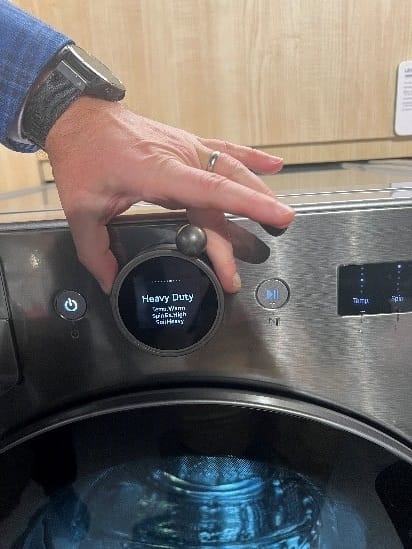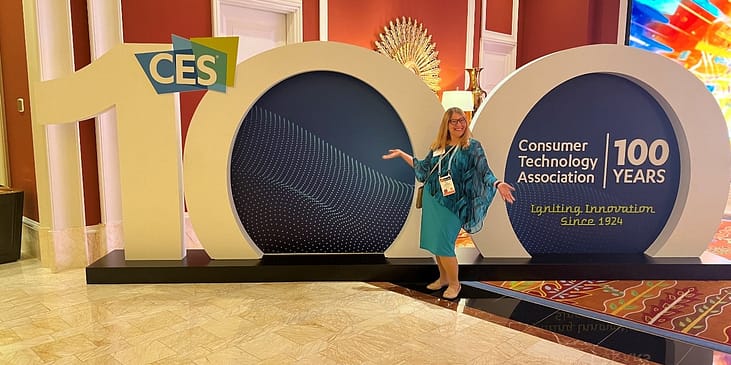In 2024, Disability Inclusion took center stage at CES!
By Kat Zigmont
WID again had the privilege of attending the Consumer Electronics Show (CES) as part of the Consumer Technology Association (CTA) Foundation‘s Accessibility Leaders cohort. This year was the 100th anniversary of the Consumer Electronics Association, and seeing the progression of technology over the last century was a humbling experience. This year, there was a noticeable acknowledgment of disability inclusion throughout the event.
From the L’Oréal keynote, where they introduced inclusive beauty tech, including the prototype for HAPTA, a handheld makeup applicator. This motion-stabilizing device leverages technology to aid individuals with limited mobility, grip strength, wrist mobility, tremors, and reduced hand sensation in achieving precise and comfortable makeup application.
To LG, who showcased its Universal UP Kit. The kit provides attachments, making appliances more accessible to use without the need for specialized, expensive accessible products. The four Universal Up Kits cater to various needs, offering solutions like detachable handles for washers, a wheeled strut for vacuums, a handle for clothes hangers, and an adjustable nozzle for fridges, enhancing accessibility and usability for the disability community.


As well as the series of panels and interviews focusing on inclusive design and assistive technologies. I was on one of these panels; ‘Trends in Assistive Tech’ with Matt Ater from Vispero, Sandy Lacey from Perkins School for the Blind, Mike May from American Printing House for the Blind, and moderated by Paul Amadeus Lane, a Tech Accessibility Specialist. The audience positively embraced our panel, with numerous attendees expressing interest in further discussions. Additionally, I spoke to Access Tech Live about the disability-inclusive technology being exhibited at CES this year.
Below, you will find some more innovations from CES 2024 that, in my opinion, showcased disability inclusion.
Glidance: AI-Powered Navigation
Glidance is an AI-powered assistive technology designed to help individuals with sight loss navigate independently. Equipped with obstacle detection for stationary and moving objects, Glidance ensures you can confidently navigate high-traffic areas without any hitches. Glidance’s camera and sensors work in tandem to identify and direct you to key waypoints, be it an Uber, doors, elevators, stairs, and more. The haptic handle and automatic braking system come into play as you reach your destination.
While walking down a city sidewalk or navigating through complex facilities, Glidance assists you in maintaining a straight line and avoiding obstacles, with voice feedback providing real-time updates on your surroundings. Whether traversing airports, train stations, or exploring a new city, Glidance empowers you to travel independently, offering real-time turn-by-turn navigation.

Glidance is gearing up for integration with leading navigation apps, allowing a remote assistant to interpret your surroundings visually through Glidance cameras. The updated Glidance API will seamlessly integrate Glidance with outdoor and indoor navigation apps, letting you use your preferred apps for a customized experience.
GlüxKind: Hands-Free Smart Stroller
GlüxKind‘s latest innovation is an AI-powered stroller designed for hands-free convenience. This smart stroller uses advanced technology to sense your proximity and stays within arm’s reach when in Hands-Free mode. If you happen to move out of range, it automatically stops, ensuring your child’s safety.
But that’s not all – the stroller acts like a vigilant companion, keeping an eye on the surroundings. It alerts you to potential dangers like cars, bikes, and scooters, providing an extra layer of security. The motor assist and braking functions make navigating hills a breeze, ensuring a safe and comfortable ride.
And here’s a sweet touch – the ‘rock my baby’ mode lets you soothe your little one when you’re not on the move. While GlüxKind didn’t specifically create this product for the disability community, it’s easy to see how it could be a game-changer for many disabled parents.
Lili for Life: Tools for Dyslexia
Discover the groundbreaking solution from Lili for Life that delves into the root cause of dyslexia and offers an innovative fix. They’ve identified that dyslexic individuals lack a dominant eye, leading to mirror or overlapping images that disrupt reading. Enter Lili, a product that eliminates these mirrored and superimposed images using a stroboscopic light effect. It’s like creating an artificial directing eye through pulsed light.
Their solution is a customizable lamp controlled through a smartphone app. You find the right frequency to correct the core issue of dyslexia, and voila! The lamp can then be used across all your reading materials. That’s not all – they’re also working on a monitor with the same functionality, set to hit the market soon. This company is making waves in the dyslexia space with its ingenious light-based solution.

Cephable: Alternative Input Controls
Cephable is dedicated to making technology accessible to everyone through the development of assistive technology, encompassing hardware, software, and AI-driven solutions. Their mission is to provide diverse means for individuals to control their computers, games, and software, creating an inclusive and enjoyable experience for all.
For individuals with disabilities, Cephable goes beyond traditional input methods, and the best part is that it’s free for end-users. Their platform transforms the interaction with Microsoft and Mac operating system applications by incorporating alternative input controls such as voice, switch, head movement, facial expressions, and virtual buttons. These controls are intelligently mapped to profiles and designed around input and output controls, expanding communication with the computer beyond the conventional keyboard and mouse.
Cephable offers a range of Control Profiles, including web browsing, word processing, mouse basics, and media controls. Experience the freedom to tailor your digital world to your capabilities with Cephable’s innovative platform, leveling the playing field for a more inclusive and enjoyable technological landscape.
Ximira: AI Virtual Assistant for the Blind
Ximira introduces PHINIX (Perceptive Helper with Intelligent Navigation and Intuitive eXperience), a groundbreaking wearable system designed to empower blind individuals, enabling them to navigate safely and independently. PHINIX boasts essential features such as hands-free operation, long-lasting mobility, and a design that seamlessly integrates with users’ senses. Its user-friendly and adaptable nature ensures easy adoption, even for those with limited technical knowledge. The system’s real-time navigation assistance, compact size, and wireless capabilities make it a discreet and comfortable companion for daily use. PHINIX embraces an open and collaborative approach, inviting contributions and fostering innovation in assistive technology.
Discover the flexibility of PHINIX, which provides users with three interactive modalities for a personalized experience. Through Auditory/Voice, users can receive information via text-to-speech and give commands using advanced speech recognition through a headset. Haptic/Gestural functionality involves custom vibratory messages through wristbands, with users able to command the system through gestures. Additionally, PHINIX supports a Graphical User Interface (GUI)/Touch interaction via mobile phone or tablet applications, already equipped with assistive adaptations for the vision loss community. You can tailor their experience by configuring the nature, quantity, and volume of information each modality provides to avoid information overload.
TranscribeGlass: Wearable Device for Captions
TranscribeGlass is an affordable and comfortable wearable assistive technology device designed for individuals who are d/Deaf, Hard of Hearing (HoH), or anyone seeking improved comprehension of spoken communication through captions. This innovative device projects closed captions onto a heads-up display in the user’s field of vision in near-real-time, significantly enhancing their ability to understand spoken content.
The TranscribeGlass mobile companion app, connected to the selected caption source, transmits captions to the heads-up display via Bluetooth Low Energy. Notably, TranscribeGlass is designed to be compatible with most glasses, ensuring usability even for individuals who wear glasses. Explore a new dimension of accessible communication with TranscribeGlass.

Making Space: Talent Aquisition and Learning Platform
Making Space is a talent acquisition and learning experience platform dedicated to unlocking employment opportunities for disabled, overlooked, and underrepresented communities. Their platform offers user-friendly and accessible courses backed by employer support, enabling a seamless transition from education to employment. Emphasizing skill development aligned with ideal job opportunities, Making Space focuses on swift placements, career growth, and enhanced mobility.
Here’s the deal – it’s free for potential employees. Employers collaborate with Making Space to tailor training to their company standards, creating tangible pathways to employment. Making Space isn’t just for job seekers; it’s a dynamic platform for companies to train and connect with prequalified talent from diverse communities.
Designed to bridge the education-employment gap, this platform facilitates tangible pathways to employment and career advancement through employer-supported courses. By empowering individuals to prequalify for jobs independently, Making Space embraces a data-driven hiring process, resulting in faster, better-matched hires and improved retention rates.
Leafi: Smart Blinds Tool
Leafi transforms your existing blinds into smart blinds, offering complete control and easy programming through their user-friendly app. With Leafi, managing your blinds is as easy as a voice command. Whether it’s a simple “open bedroom blinds” or a precise “close living room blinds by 20%,” Leafi connects effortlessly to your Google Home or Amazon Alexa, bringing convenience to your fingertips. Create a daily routine by scheduling your blinds. Program individual or grouped windows, explore multiple settings throughout the day or sync with the sunrise/sunset for a tailored experience.
Leafi works with vertical blinds that utilize a tilt wand. The Leafi unit replaces the tilt wand, which requires no tools and takes less than 5 minutes to install. Once the initial setup is done, all your family members can pair their phones with the Leafi App. The blinds can be controlled from anywhere; no need to be in the house.


0 comments on “Disability Inclusion at CES while marking 100 years of the Consumer Electronics Association”